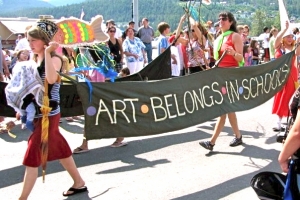Currently, our country’s education system is under attack due to a troubling trend: the neglect of art programs in schools. Serious budget cuts to the National Endowment for the Arts are resulting in many public schools struggling to maintain their arts programs (Mahnken). This is causing many schools to lay off teachers and, in extreme cases, cut funding for arts programs entirely (Fang). While many supporters of budget cuts would say that the STEM field should receive more funding because of the potential work applications and use in research, this ignores all the developmental, interdisciplinary, historical, and expressive benefits of art in education.

When teachers provide diverse activities for children to choose from, they are not only providing options for children to discover personal interests, they are also opening up children to new experiences, which is, of course, crucial for development. A teacher’s primary goal is not only to educate, but to aid in children’s development, and art can provide a perfect outlet for this. Simply providing access to art materials, such as crayons or paints, can help children develop their fine motor skills, which are a necessity for skills such as writing (Hwang Lynch). Exposure to new and varied experiences can help facilitate a child’s development of language and vocabulary. Thus, exposure to art in the classroom can help children gain a myriad of vocabulary, such as words relating to shape, color, texture, and process of creation (Hwang Lynch).
The inclusion of art in education enriches a student’s ability to express creativity, which, although overlooked, is a critical skill. A strong sense of creativity is applicable in problem solving processes and the ability to adjust to new or unfamiliar tasks. The ability to think creatively may help a student who struggles with abstract concepts, such as algebra. Creativity can also improve social intelligence, since it fosters self-expressive skills (Zimmerman).
Clearly, art can aid mental development, and it has many interdisciplinary applications as well. For example, it has been shown that asking students to illustrate what they want to write about improves their ability to describe the scene or character in writing (Noden & Moss). In a biology course, in order to ensure that students can fully grasp the why parts of the cell look and interact, the teacher could design a project where the student has to create a replica of the cell. Art has the ability to awaken talents in students who think differently than their classmates and make use of their strengths. Simultaneously, it forces students who are not as experienced in the arts to think in more abstract and creative ways. Thus, for teachers, an art-infused curriculum can be a powerful tool in developing the minds of their students. After all, it has been shown in multiple studies that there is a correlation between participation in the arts and academic success (Hwang Lynch).
Art has been a constant force in human history and can show insight into the lives of people in the past (Reiss). Art breathes life into society, and its absence would be catastrophic (Bazalgette). Art can also bring attention to the negativity present in our society: the racism, homophobia, sexism and any number of injustices, injustices that can only be expressed in such a human form. After all, art is uniquely human.
I have been an artist since I was a small child, and one of my earliest memories is being praised by my parents for drawing “fireworks” or, swirly, chaotic scribbles on a page of sketch paper. My parents’ encouragement of my art and my personal love for it is what truly solidified my practice for it. For me, art was an escape. I was able to travel into the world of my drawings. Just imagine my excitement when I started attending school and learned that art would be one of my regular classes. While I am now a good student, I struggled in my younger years, so art class acted as a release. It was the reason I wanted to go to school each day.
As I grew older, art allowed me to better understand myself. My school did not have the best arts program, but my art classes allowed me to express what I kept pent up.
One could make the argument that careers in the sciences make more money, that the sciences are a more revered career, that a person who studies them will gain more respect. One could choose to ignore all the evidence that art enriches development and learning and say that in the STEM fields, students gain more skills than when studying arts. Obviously scientific research is crucial in the development of our society. However, just like the world needs scientists, children need art, and the world needs artists.
Arts provide children with the chance to explore their identity, gain confidence, move around, improve their technical skills, and make beautiful, precious things. No one can deny the spark that art ignites in children. All of educational benefits aside, why deny children the chance to have fun?
Works Cited
Bazalgette, Peter. “We Have to Recognise the Huge Value of Arts and Culture to Society.” The Observer, Guardian News and Media, 26 Apr. 2014,
Fang, Marina. “Public Schools Slash Arts Education And Turn To Private Funding.” ThinkProgress, 5 Aug. 2013,
Hwang Lynch, Grace. “The Importance of Art in Child Development.” PBS, Public Broadcasting Service, 25 May 2012,
Mahnken, Kevin. “An Arts Education Crisis? How Potential Federal Cuts Could Decimate School Arts Programs.” The 74 , 29 Jan. 2017,
Noden, Harry, and Moss, Barbara. “Nurturing Artistic Images in Student Reading and Writing.” The Reading Teacher, vol. 48, no. 6, Mar. 1995, pp. 532–534.
Reiss, Mitchell B. “The Value and Importance of the Arts and the Humanities in Education and Life.” by Barbara Ernst Prey. Huffington Post, 9 Nov. 2014,
Zimmerman, Enid. “Reconceptualizing the Role of Creativity in Art Education Theory and Practice.” Studies in Art Education, vol. 50, no. 4, 2009, pp. 382–399.
JILLIAN SMIDA-WOOD
